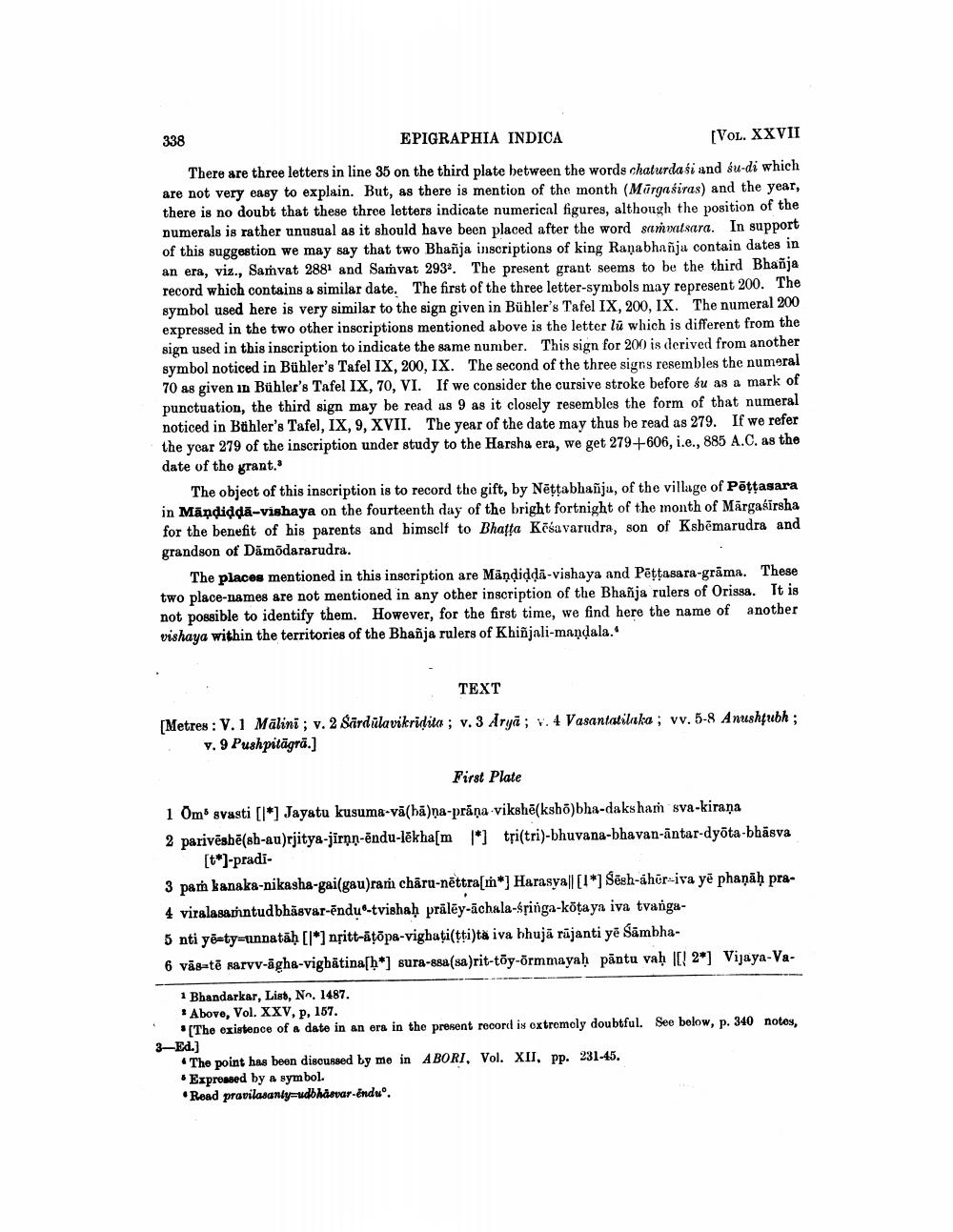________________
338
EPIGRAPHIA INDICA
[VOL. XXVII
There are three letters in line 35 on the third plate between the words chaturdasi and su-di which are not very easy to explain. But, as there is mention of the month (Margasiras) and the year, there is no doubt that these three letters indicate numerical figures, although the position of the numerals is rather unusual as it should have been placed after the word samvatsara. In support of this suggestion we may say that two Bhañja inscriptions of king Ranabhañja contain dates in an era, viz., Samvat 2881 and Samvat 293. The present grant seems to be the third Bhanja record which contains a similar date. The first of the three letter-symbols may represent 200. The symbol used here is very similar to the sign given in Bühler's Tafel IX, 200, IX. The numeral 200 expressed in the two other inscriptions mentioned above is the letter lu which is different from the sign used in this inscription to indicate the same number. This sign for 200 is derived from another symbol noticed in Bühler's Tafel IX, 200, IX. The second of the three signs resembles the numeral 70 as given in Bühler's Tafel IX, 70, VI. If we consider the cursive stroke before su as a mark of punctuation, the third sign may be read as 9 as it closely resembles the form of that numeral noticed in Bühler's Tafel, IX, 9, XVII. The year of the date may thus be read as 279. If we refer the year 279 of the inscription under study to the Harsha era, we get 279+606, i.e., 885 A.C. as the date of the grant."
The object of this inscription is to record the gift, by Neṭṭabhanja, of the village of Pētṭasara in Mändidḍā-vishaya on the fourteenth day of the bright fortnight of the month of Margaśirsha for the benefit of his parents and himself to Bhatta Kesavarudra, son of Kshēmarudra and grandson of Damodararudra.
The places mentioned in this inscription are Mänḍiḍda-vishaya and Pēṭṭasara-grāma. These two place-names are not mentioned in any other inscription of the Bhañja rulers of Orissa. It is not possible to identify them. However, for the first time, we find here the name of another vishaya within the territories of the Bhañja rulers of Khiñjali-mandala.
TEXT
[Metres: V. 1 Malini; v. 2 Särdülavikridita; v. 3 Arya; v. 4 Vasantatilaka; vv. 5-8 Anushtubh; v. 9 Pushpitāgrā.]
First Plate
1 Om3 svasti [*] Jayatu kusuma-va(ha)na-prāņa vikshē(kshō)bha-daksham sva-kirana
2 parivésbé(sh-au)rjitys-jirop-ndu-lékha[m] tri(tri)-bhuvana-bhavan-Antar-dyota-bhasva
[*]-pradi
3 par kanaka-nikasha-gai(gau)ram charu-nettra[m*] Harasya|| [1*] Sesh-aher-iva ye phaṇāḥ pra
4 viralasantud bhisvar-Fadu-tvishab präley-achala-spinga-kötayn iva tvangs
5 nti ye-ty-unnataḥ [*] nritt-aṭopa-vighati(tti)ta iva bhujā rājanti yē Sambha
6 vās tē sarvv-agha-vighatina[ḥ*] sura-ssa (sa)rit-toy-ormmayaḥ pantu vaḥ [ 2*] Vijaya-Va
1 Bhandarkar, List, No. 1487.
Above, Vol. XXV, p, 157.
[The existence of a date in an era in the present record is extremely doubtful. See below, p. 340 notes,
3-Ed.]
The point has been discussed by me in ABORI, Vol. XII, pp. 231-45.
Expressed by a symbol.
Read pravilasanly-udbhäevar-endu.




